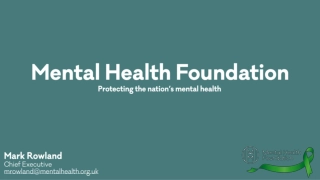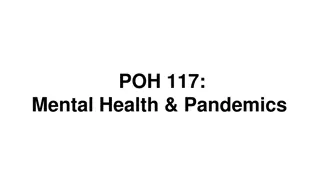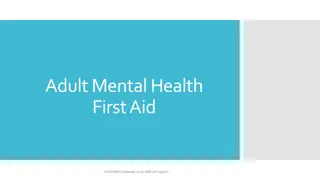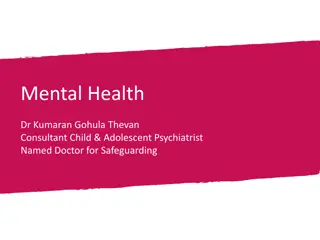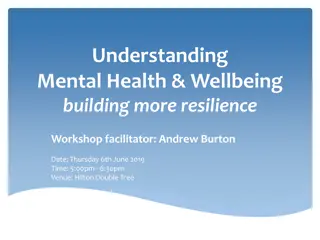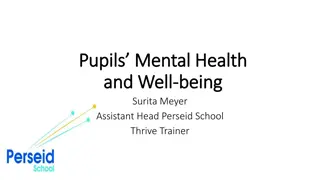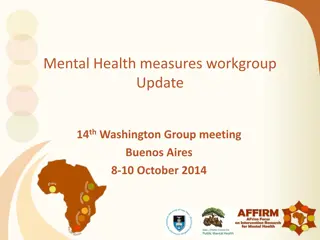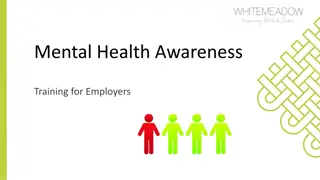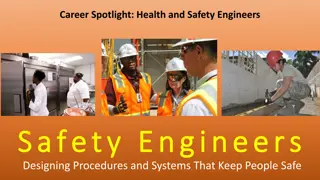Understanding the Impact of Mental Health on Workplace Safety
Workplace safety is crucial for safeguarding employees, consumers, and the public. Mental health plays a significant role in workplace safety, challenging misconceptions and highlighting the importance of addressing mental health issues. Recognizing and managing mental health concerns can enhance employee morale, productivity, and overall well-being, ultimately contributing to a safer work environment.
Download Presentation

Please find below an Image/Link to download the presentation.
The content on the website is provided AS IS for your information and personal use only. It may not be sold, licensed, or shared on other websites without obtaining consent from the author. Download presentation by click this link. If you encounter any issues during the download, it is possible that the publisher has removed the file from their server.
E N D
Presentation Transcript
How Mental Health Affects Workplace Safety: Why Understanding Mental Health Helps Everyone Sarah Papesh, LPCC-S, CTP
Importance of Workplace Safety Safety first, safety last, safety always! Reducing threat of risk or harm to employees, employers, consumers, and public Reducing cost to employers, employees, consumers, and public
Mental health only affects the individual Mental health is not a workplace issue Only significant mental illness impacts the workplace Workplace violence is a direct result of individuals with an underlying mental illness Myths About Mental Health and Workplace Safety
Reducing the Stigma Mental health is everyone s responsibility Mental health is often misunderstood and overlooked Mental health is as important as physical health
Why Focus on Mental Health? Nearly 1 in 5 US adults aged 18 or older reported experiencing diagnosable mental illness at least once in the last year More than half of these will go untreated Stressful occupations impact those experiencing diagnosable mental illness
Other Factors Related to Poor Mental Health Social/familial issues Substance use/abuse Health Conditions Heart disease Diabetes Respiratory illness Gastrointestinal disorders Disorders that affect bone, muscles, joints Decreased immunity Chronic illness
Can be just as detrimental as unmanaged mental illness Can be influenced by unmanaged mental illness 71% of adults reported at least one symptom of stress, such as a headache or feeling overwhelmed or anxious in the Workplace
Why do we need to consider mental health and stress in the workplace? Can directly impact: Employee morale Attendance Job performance and productivity. Engagement with one s work Communication with coworkers Physical capability and daily functioning Can lead to higher rates of disability and unemployment Can lead to burnout Unmanaged mental health and stress directly impact workplace safety Safety is about people understanding human factors can help with workplace safety
Impact to Individual Poor sleep/fatigue Poor eating habits Weight fluctuations Illness Poor coping/ coping threshold Low morale Lack of motivation No interest Anxiety Irritability/short temper Concentration/focus issues Working more slowly Substance use/abuse Workplace aggression/violence
How does this impact workplace safety? Safety problems due to human error can be a direct result of unmanaged stress or poor mental health An employee dealing with such disorders may struggle to participate in social aspects at work, concentrate on one task at a time, put their full attention and effort into daily tasks, and often feel like they can t bring their mental health needs to their employer s attention.
Examples Examples Lack of motivation/no interest Carelessness Sloppiness Poor concentration/focus Poor sleep/fatigue Can lead to absences Poor concentration/focus Slower work speed Absences Low/understaffing Overworked staff Related accidents Perpetuate a cycle Impaired immune system Increased illness Spread of illness
Examples Poor coping Substance abuse Medication abuse/misuse Can impact worker health or reaction time May not be done during work hours Can lead to distraction, which can directly result in accidents Cumulative effects can cause one to reach his/her coping threshold Puts one s ability to function at risk
MOST EXTREME Workplace violence/aggression Workplace violence is a threat everywhere On the decline Vast majority of people who are violent do not suffer mental illness Can further perpetuate the cycle
How to tell when someone is struggling with poor mental health/unmanaged stress Mood changes Cognitive changes Physical changes Behavioral changes
Signs may include . . . They may be making more mistakes than normal or having trouble with decision-making and concentration. They may become more irritable and sensitive to criticism. They may become increasingly absent or alternatively start work excessively, staying late and bypassing lunch breaks. They may exhibit physical symptoms, such as being constantly tired or suffering from a cold that won t go away. They may take less care with their appearance or show signs of drinking alcohol to help them switch off in the evenings.
How to Help Others Reduce the stigma! Create a supportive environment where mental illness and stress aren t taboo Create an environment of inclusivity Check in on co-workers/employees Learn your team so you can recognize uncharacteristic behavior Encourage health and wellness and practicing good self-care Speak up if something is different/amiss Turn the work environment into a welcoming environment Providing leadership through empathy and social support has also shown to reduce occupational injuries
How to Help Yourself Take time for yourself use sick time, vacation days, personal days when needed Practice good, healthy self-care Know yourself Speak to HR Utilize employer sponsored benefits Seek out social supports Ask for help Seek out professional services
References American Psychiatric Association Foundation: Center for Workplace Mental Health. (2012). Violence in the workplace. Retrieved from http://workplacementalhealth.org/Mental-Health-Topics/Violence-in-the-Workplace Centers for Disease Control and Prevention. (2018). Mental health in the workplace: Mental health disorders and stress affect working-age Americans. Retrieved from https://www.cdc.gov/workplacehealthpromotion/tools-resources/workplace- health/mental-health/index.html EW Group. (n.d.). Why is mental health awareness at work so important? Retrieved from https://theewgroup.com/mental-health- awareness-work/ Jacob, I. G. (2006). Depression s impact on safety. Occupational Health and Safety. Retrieved from https://ohsonline.com/Articles/2006/10/Depressions-Impact-on-Safety.aspx?Page=1 Total Safety. (2016). Stress on the job can impact workplace safety. Retrieved from https://www.totalsafety.com/insights/stress-on- the-job-can-impact-workplace-safety/ Wilhite, L. (2018). Mental health safety in the workplace. Onsite Safety: Creating Safe Solutions. Retrieved from https://www.onsitesafety.com/safety-articles/mental-health-safety-workplace/ Work Safe. (n.d.). Mental health: Safety basics. Retrieved from https://www.worksafe.vic.gov.au/mental-health-safety-basics Young, K. (2018). Mental health and safety performance. Trinity Safety Group. Retrieved from https://www.trinitysafetygroup.com/employee-mental-health-and-safety
Thank you for your time! Psych and Psych Services 440-323-5121 www.psychandpsych.com



